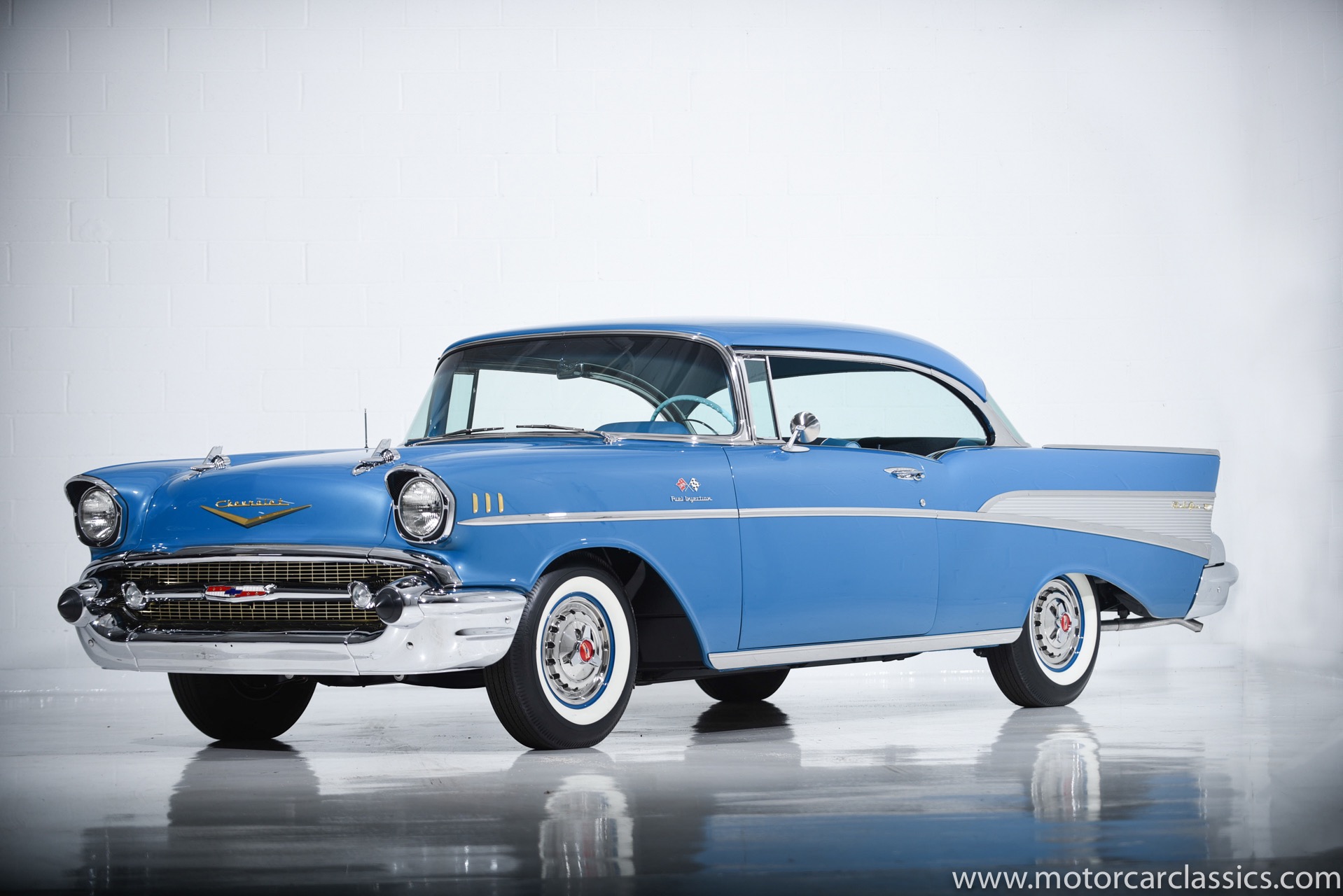The Iconic 1957 Chevrolet Bel Air: America’s Post-War Dream Car
The 1957 Chevrolet Bel Air is one of the most iconic American cars ever made. With its dramatic tailfins, sleek styling and powerful V8 engine, the ’57 Chevy captured the optimism and exuberance of postwar America. This full-sized automobile encapsulated the American dream and still turns heads over 60 years later.
Overview of the 1957 Chevy Bel Air
Manufacturer: Chevrolet division of General Motors
Production run: 1955 – 1957
Body style: 2-door coupe, convertible, 4-door sedan, 4-door station wagon
Layout: Front-engine, rear-wheel drive
Engine: 235 CID “Blue Flame” inline 6-cylinder, 283 CID “Turbo Fire” V8, 348 CID “Turbo Thrust” V8
Transmission: 2-speed Powerglide automatic, 3-speed manual
Power: Up to 250 hp (V8 models)
The third generation Bel Air debuted for the 1955 model year with an all-new exterior and interior design. But it was the 1957 restyle that turned the Bel Air into an American icon.

Flamboyant ’50s Styling
The 1957 Bel Air’s dramatic new look was influenced by contemporary fighter jets and represented the jet age and space age styling of the era. It featured:
Prominent tailfins that swept up from the rear quarters
Hooded headlights and egg-crate grilles
Curvaceous bumpers and bodysides
Distinctive two-tone and three-tone color schemes
Bel Airs came in Sport Coupe and Convertible body styles. Four-door sedans and Nomad station wagons were also available. Buyers could customize their cars with Continental kits, fender skirts, and dual exhaust.

Advanced Engineering Under the Hood
The ’57 Bel Air was more than just flashy looks. Underneath the hood, Chevrolet’s advanced overhead valve V8 engines provided plenty of power.
Engine options included:
235 CID Blue Flame inline 6-cylinder (140 hp)
283 CID Turbo Fire V8 (185-220 hp)
348 CID Turbo Thrust V8 (250-280 hp)
Fuel injection option boosted the 283 V8 to 283 hp
The standard transmission was a 3-speed manual. The 2-speed Powerglide auto transmission was available as an option.

The Hot Rodder’s Favorite
The high-powered V8 models made the ’57 Bel Air a favorite for hot rodders and custom car builders. The excellent chassis and suspension design also made the Bel Air an ideal platform for racing and performance modifications.
Many 1/4 mile drag racers chose the lightweight 2-door post models and swapped in even larger displacement V8s from Chevrolet’s truck lines. Groups like the Ramchargers raced highly-tuned fuel-injected Bel Airs to break speed records at drag strips around the country.

Sales Success for Chevy
The radical restyle for 1957 proved to be a huge sales success for Chevrolet. Bel Air production soared to over 760,000 units, the most ever for this model. The Bel Air made up nearly 25% of Chevrolet’s total production for 1957.
It handily outsold its closest competitor, the Ford Fairlane 500, by over 300,000 units. This sales leadership further cemented Chevrolet’s title as America’s number one brand.

The Tri-Five Chevy Collector Community
Today the 1955, 1956 and 1957 Chevrolets are grouped together by collectors and enthusiasts as the “Tri-Five Chevys.” Excellent parts availability and interchangeability between model years makes the Tri-Five cars favorites for restoration.
The 1957 Bel Air, as the most flashy and desirable of the three, commands the highest prices and interest. Concours-restored convertible and Sport Coupe models can sell for over $100,000. Even worn-out project cars get bid up quickly due to the 1957’s immense popularity.
Big national events like the Tri-Five Nationals help keep enthusiasm strong within the Tri-Five community. Car shows and cruises allow owners to proudly display these American classics.

The ’57 Chevy’s Place in Pop Culture
The 1957 Chevy has reached icon status in American pop culture. It remains one of the most recognizable cars from the fabulous ’50s.
It starred in hit songs like the Beach Boys’ “409” and Jan and Dean’s “Dead Man’s Curve”
It was immortalized in movies like American Graffiti and Grease
Diecast and model kits remain popular collectibles
It still appears in advertising imagery evoking 1950’s cool
The 1957 Chevy Bel Air stands as one of greatest triumphs of GM design and represents the golden era of the American automobile. More than six decades later, this car still captivates old and young generations alike. For many, the ’57 Chevy is what comes to mind when thinking of the classic American car.

Frequently Asked Questions about the 1957 Chevy Bel Air
Here are answers to some common questions about this iconic American classic car:
What made the ’57 Bel Air so special compared to earlier models?
The 1957 model year brought an all-new exterior design with very distinct styling cues like the tailfins and two-tone paint that made it stand out. It was a revolutionary departure from previous models.
What engine options were available in 1957?
There were inline 6-cylinder and several V8 options: Blue Flame I6, Turbo Fire 283 V8, Turbo Thrust 348 V8. Fuel injection was a rare option on the 283. Larger displacement “W” series truck V8s were often swapped in.

How much power did the top engines produce?
The standard 283 cubic inch Turbo Fire V8 made 220 horsepower with a 4-barrel carburetor. Optional fuel injection brought it up to 283 hp. The 348 Turbo Thrust delivered 250 to 280 hp depending on configuration.
How well did the ’57 Bel Air sell compared to competitors?
It was a huge sales success, outselling rival makes by wide margins. Total Bel Air production neared 762,000 units compared to around 447,000 Ford Fairlane 500s sold.
What body styles were available for the ’57 Bel Air?
It came in 2-door Sport Coupe, 2-door Convertible, 4-door Sedan, and 4-door Nomad wagon configurations. The hardtop Sport Sedan was discontinued.




